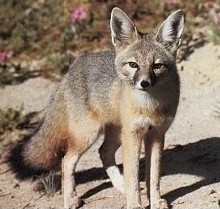|
| Query: Vulpes velox | Result: 1st of 28 | |
Swift Fox (Vulpes velox) - Wiki
| Subject: | Swift Fox (Vulpes velox) - Wiki
| |

| Resolution: 220x209
File Size: 21371 Bytes
Upload Date: 2007:09:04 16:15:22
|
Swift Fox
From Wikipedia, the free encyclopedia
[Photo] Swift Fox (Vulpes velox). Source: http://www.defenders.org/wildlife/save/foxes.html
The swift fox (Vulpes velox) is a small fox found in the western grasslands of North America, such as Colorado, New Mexico and Texas. They also live in Manitoba, Saskatchewan and Alberta in Canada.
Taxonomy
The swift fox is closely related genetically to the kit fox Vulpes macrotis, but occupies a different geographical range. The two have historically been regarded as different species, for reasons basically related to size: the kit fox is slightly smaller than the swift fox, and the former has a narrower snout. However, hybrids between the two occur naturally where their ranges overlap, and some mammalogists (e.g. Dragoo et al, 1990) classify the two as subspecies of a single species, usually treated as Vulpes velox (with the swift fox being described as V. velox velox and the kit fox as V. velox macrotis). The molecular genetics evidence is not conclusive however, and some of those who have used it (e.g. Mercure et al, 1993) continue to treat the swift fox and kit fox as separate species.
Conservation status
The species was extirpated from Canada by 1938, but a reintroduction programme started in 1983 has been successful (Sillero-Zubiri & Hoffmann, 2004). However, in May 2000, the Canadian Species at Risk Act listed the swift fox as an endangered species in Canada. In general, though, the IUCN Red List characterises it as of Least Concern, because populations elsewhere in its range are stable or increasing.
General characteristics
Swift foxes weigh 2 or 3 kg (4 to 7 pounds). They are primarily nocturnal, and are more heavily dependent on their dens than most North American canids. They suffer serious predation by coyotes.
Like most canids, the swift fox is an omnivore. Rabbits, mice, ground squirrels, birds, insects and lizards are staples. Grasses and fruits round out their diet. However, like any efficient forager, the swift fox takes advantage of seasonal foods. During the summer, adults eat large amounts of insects, including beetles and grasshoppers and feed their young with larger prey items. Winter-killed deer and other carrion may also be important food sources.
Adult swift foxes live in pairs and may mate for life. They may occupy up to thirteen dens in one year, moving because prey is scarce or because skin parasites build up inside the den. Sometimes they make other burrows from other animals bigger, even though they are completely capable of digging one on their own. Recent research has shown that social organization in the swift fox is unusual among canids, since it is based on the females. Females maintain territories at all times, but males emigrate if the resident female is killed or removed.
http://en.wikipedia.org/wiki/Swift_fox
| The text in this page is based on the copyrighted Wikipedia article shown in above URL. It is used under the GNU Free Documentation License. You may redistribute it, verbatim or modified, providing that you comply with the terms of the GFDL. |
^o^
Animal Pictures Archive for smart phones
^o^
|
|
|